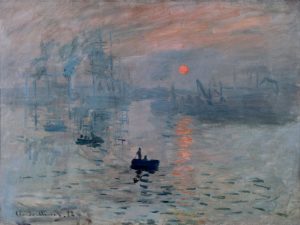Zoom On “Impression, Soleil Levant”, Claude Monet’s Most Famous Painting
“Impression, soleil levant” is probably Claude Monet’s most famous painting, but also of the Impressionist movement. And for good cause, it is this work which gave this time its name. Then there is a question: Why did this painting become so popular? Introduction of an exemplary piece that marked a turning point in the history of art.
The story of the painting “Impression, Soleil Levant”
It was the 13th of November when Claude Monet arrived at the port of Le Havre, the town where he grew up. When we see a shift in culture, the Industrial Revolution then sets the tempo for this era. The port of Le Havre, as we know it now, has little to do with it: there were no World War II bombings …
This view was then painted by Claude Monet, perhaps keeping in mind the paintings of William Turner that he had admired in London the previous year. The ambient depth of English, which we know has touched her profoundly, marks her style so much. In 1872, it may have been painted, but it would have been completed in 1873 or 1874, according to some professionals.
A very criticized first highlight
Monet ‘s work was first displayed at the exhibition ‘Société Anonyme des Artistes, Painters et Engravers’ in 1874 and has been the focus of much criticism. Like the other works by the artists present, like Renoir, Pissaro or Sisley. But if this painting is at the very root of the word “Impressionism,” it is notably due to Louis Leroy, who wrote a mocking essay on the show for Le Charivari in 1874. “Leroy, who saw the canvas of Monet, wrote about it:” What does that canvas represent? Impression! Impression! An experience I was confident of. I was wondering, too, because I’m fascinated with that, there must be some emotion in it. […] The wallpaper is more workable than the navy’s. He also titled his essay “The Impressionists’ Exhibition.” This latest movement has just been given a name by Louis Leroy: ‘Impressionism.’
We can also read about this show in other magazines: “This ludicrous array of nonsense,” “The most insane crusts,” or “Messrs Monet and Pissaro and Mademoiselle Morisot appear to have declared war on beauty.”
Zoom on the painting

On the painting “Impression, rising sun”, we can see in the foreground the silhouette of a boat occupied by two fishermen. A little further on, a second boat reinforces the depth effect. The painting is in rather cold tones, except for the sun which persists the mist. This is without a doubt the central point of the composition. Indeed, the sun is perfectly distinguished by its warm hues and its sharpness, unlike the background, where the port of Le Havre takes shape with its sailboats, steamboats and factories.
Through his painting, Claude Monet shows us a working port in the early morning. A scene very representative of the incessant development of maritime trade during the mid-19th century.
Regarding its size, the work is rather small: 48 centimeters high and 63 centimeters wide.
Bought by Ernest Hoschédé, a friend of Monet, for 800 francs, it will be sold later to Georges de Bellio, a collector, for 210 francs. The painting will remain in the family until 1938, when it joined the Musée de Marmottan in Paris.
The “impressionism” story
The product of much study and debate is impressionism. In France, during the second part of the 19th century, this movement was born. The Impressionists revolutionised the art of this period, in comparison with the gloomy and mysterious canvases of academic paintings. The techniques change, the light, the mood and the eye of the painter become the painting’s real focus. Notice that this modern form of art nevertheless took about 30 years for contemporary eyes to get used to it.
The Marmottan Monet museum, a Mecca of Impressionism

The Mormottan Museum, which became the Mormottan Monet Museum in 1990, is situated in Paris’ 16th arrondissement.
This former mansion was originally a hunting lodge built for the Duke of Valmy (1802-1868), Marshal Christophe Edmond Kellerman. It was acquired in 1882 by the lawyer, politician and art dealer Jules Marmottan, who would store his collections devoted to the Napoleonic era there. His uncle, Paul, an art historian who was also a collector, later made it his home when he died in 1934 at the Academy of Fine Arts. The Museum of Marmottan was born.
This place will turn into a hotbed of Impressionism fast. The collection of the museum contains more than 100 Claude Monet masterpieces as well as many Gauguin, Guillaumin, Renoir, Sisley paintings …
However, the museum has other treasures, although it contains the finest impressionist works. Indeed, it houses an ensemble of Empire-style sculptures, furniture and works of art.
You should also read : “Le Déjeuner Sur L’herbe, a Work Of Art to Discover At The Musée d’Orsay“


